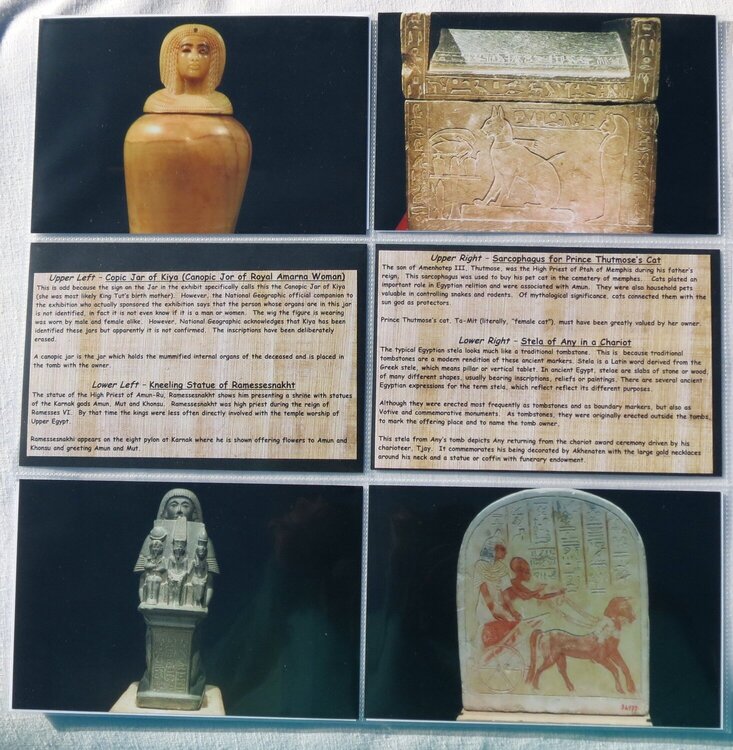Join us today at 9:00am PT / 12:00pm ET | Details Here.


 Give a Cheer
Give a Cheer
Upper Left – Copic Jar of Kiya (Canopic Jor of Royal Amarna Woman)
This is odd because the sign on the Jar in the exhibit specifically calls this the Canopic Jar of Kiya (she was most likely King Tut's birth mother). However, the National Geographic official companion to the exhibition who actually sponsored the exhibition says that the person whose organs are in this jar is not identified, in fact it is not even know if it is a man or women. The wig the figure is wearing was worn by male and female alike. However, National Geographic acknowledges that Kiya has been identified these jars but apparently it is not confirmed. The inscriptions have been deliberately erased.
A canopic jar is the jar which holds the mummified internal organs of the deceased and is placed in the tomb with the owner.
Lower Left – Kneeling Statue of Ramessesnakht
The statue of the High Priest of Amun-Ru, Ramessesnakht shows him presenting a shrine with statues of the Karnak gods Amun, Mut and Khonsu. Ramessesnakht was high priest during the reign of Ramesses VI. By that time the kings were less often directly involved with the temple worship of Upper Egypt.
Ramessesnakhi appears on the eight pylon at Karnak where he is shown offering flowers to Amun and Khonsu and greeting Amun and Mut.
---
Upper Right – Sarcophagus for Prince Thutmose's Cat
The son of Amenhotep III, Thutmose, was the High Priest of Ptah of Memphis during his father's reign. This sarcophagus was used to buy his pet cat in the cemetery of memphes. Cats plated an important role in Egyptian relition and were associated with Amun. They were also household pets valuable in controlling snakes and rodents. Of mythological significance, cats connected them with the sun god as protectors.
Prince Thutmose's cat, Ta-Mit (literally, “female cat”), must have been greatly valued by her owner.
Lower Right – Stela of Any in a Chariot
The typical Egyptian stela looks much like a traditional tombstone. This is because traditional tombstones are a modern rendition of these ancient markers. Stela is a Latin word derived from the Greek stele, which means pillar or vertical tablet. In ancient Egypt, stelae are slabs of stone or wood, of many different shapes, usually bearing inscriptions, reliefs or paintings. There are several ancient Egyptian expressions for the term stela, which reflect reflect its different purposes.
Although they were erected most frequently as tombstones and as boundary markers, but also as Votive and commemorative monuments. As tombstones, they were originally erected outside the tombs, to mark the offering place and to name the tomb owner.
This stela from Any's tomb depicts Any returning from the chariot award ceremony driven by his charioteer, Tjay. It commemorates his being decorated by Akhenaten with the large gold necklaces around his neck and a statue or coffin with funerary endowment.
No products have been added to this project.
Thanks for spreading positivity!
May 07, 2013
February 28, 2013
February 26, 2013
February 24, 2013
February 21, 2013
February 19, 2013
February 18, 2013
February 18, 2013
February 18, 2013
February 18, 2013
February 17, 2013
February 16, 2013
February 16, 2013
February 16, 2013
February 16, 2013
February 15, 2013
February 15, 2013
February 15, 2013
February 15, 2013
February 15, 2013